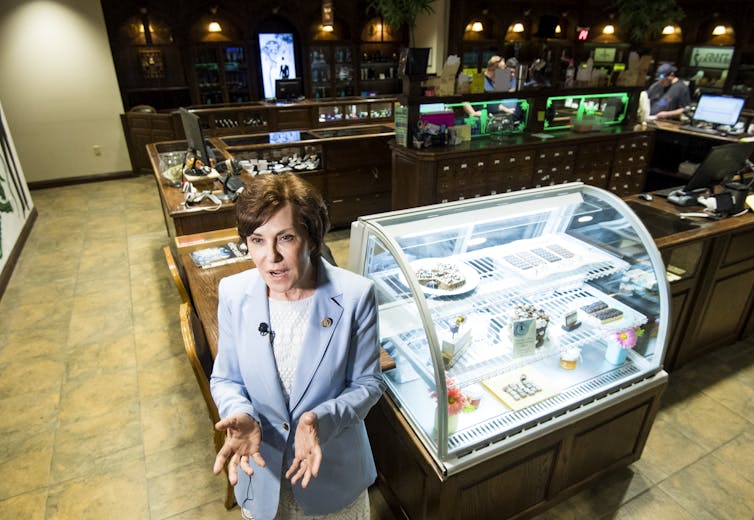Legalizing marijuana, once a pipe dream on Capitol Hill, takes an important step forward
- Written by Rosalie Liccardo Pacula, Professor of Health Policy & Management, USC Sol Price School of Public Policy & Senior Fellow, Leonard D Schaeffer Center for Health Policy & Economics, University of Southern California
In early December, the House of Representatives passed the Marijuana Opportunity Reinvestment and Expungement Act, or the MORE Act[1].
The bill sought to decriminalize marijuana nationally by removing cannabis from the federal government’s Schedule I controlled substance list[2]. That category indicates the drug has high potential for abuse and no therapeutic value. It also includes drugs like methamphetamine and heroin.
The bill is a long way from passage. With a new Congress just seated, it would need to be reintroduced and pass again in the House. Even if that happens, it is unlikely to get through the Senate.
Still, the initial success of the MORE Act is an important sign that sentiment in Washington is changing, guided by increasing public backing for cannabis reform. Two-thirds of Americans[3] now support legalizing the drug.
As a health policy professor[4] and president of the International Society for the Study of Drug Policy[5], I have followed the growing acceptance of cannabis policy reform for several decades and see both strengths and weaknesses of the most recent proposal.
Correcting Past Wrongs
Fifteen states and Washington, D.C. - places were 33% of the U.S. population lives – have legalized recreational marijuana[6]. An additional 21 states have legal medical marijuana markets. Disparities between federal and state marijuana laws in these various jurisdictions have – at a minimum – generated market hurdles and have done far more damage than that in some communities.
Forty percent of U.S. drug arrests in 2018[7] were for marijuana offenses, despite state legalization laws. The vast majority of people arrested were African Americans.
The MORE Act took several steps to try to correct the injustices caused by federal prohibition. It would have authorized a 5% tax on the sale of cannabis products to fund reinvestment in minority communities most harmed by the war on drugs[8].
It also would have expunged some cannabis-related offenses – essentially removing these offenses from people’s criminal records – which is important for undoing some of the harm caused by what the ACLU has identified as racial disparity in enforcement[9]. It could not, however, address the longer-term damage a criminal record causes Black families[10], such as the reduced family income and limited educational opportunities.
[Expertise in your inbox. Sign up for The Conversation’s newsletter and get expert takes on today’s news, every day.[11]]
What was left out
While the MORE Act would have made cannabis a legal product for commercial sale nationally, just like apples or tomatoes, it did so without addressing consumer safety matters afforded to even these basic goods. Specifically, the MORE Act did not fund agencies that provide consumer protections of standard agricultural goods and medications.
For example, regulation of cannabis cultivation by the Department of Agriculture would allow the government to enforce bans on illegal pesticides and test plants for consumption.
Similarly, regulatory authority granted to the Food and Drug Administration would ensure proper testing, labeling and reporting of ingredients for cannabis-infused edibles and vaping liquids, with consequences for noncompliance.
 Rep. Jacky Rosen, D-Nev., speaks with local television after her tour of The Apothecary Shoppe marijuana dispensary in Las Vegas on May 29, 2018.
Bill Clark/CQ Roll Call/via Getty Images[12]
Rep. Jacky Rosen, D-Nev., speaks with local television after her tour of The Apothecary Shoppe marijuana dispensary in Las Vegas on May 29, 2018.
Bill Clark/CQ Roll Call/via Getty Images[12]
The FDA is already trying to rein in companies[13] that market products containing cannabis and cannabis-derived compounds in ways that violate the Federal Food, Drug and Cosmetic Act[14].
The MORE Act failed to dedicate revenue to support these regulatory activities to ensure consumer safety.
This failure comes despite evidence that, when left unchecked, the industry promotes its products in ways that can generate negative health behaviors, like use of the drug by pregnant women to combat nausea[15].
Development and marketing of products aimed at youth have also resulted in poisonings[16], acute psychosis[17] and emergency room visits[18].
If Congress is serious about legalizing marijuana, it might consider using funds from the new tax revenue to set up federal standards that improve product safety and reduce unintentional harm.
The conservative-leaning Senate is more likely to support such a policy. As is, the MORE Act addresses past social injustices but misses an opportunity to regulate cannabis products for the benefit of all Americans.
References
- ^ the MORE Act (www.congress.gov)
- ^ Schedule I controlled substance list (www.dea.gov)
- ^ Two-thirds of Americans (www.pewresearch.org)
- ^ health policy professor (www.rand.org)
- ^ International Society for the Study of Drug Policy (priceschool.usc.edu)
- ^ legalized recreational marijuana (www.usnews.com)
- ^ U.S. drug arrests in 2018 (www.pewresearch.org)
- ^ minority communities most harmed by the war on drugs (ireta.org)
- ^ racial disparity in enforcement (www.aclu.org)
- ^ longer-term damage a criminal record causes Black families (www.brookings.edu)
- ^ Expertise in your inbox. Sign up for The Conversation’s newsletter and get expert takes on today’s news, every day. (theconversation.com)
- ^ Bill Clark/CQ Roll Call/via Getty Images (www.gettyimages.com)
- ^ rein in companies (www.fda.gov)
- ^ violate the Federal Food, Drug and Cosmetic Act (www.lexology.com)
- ^ use of the drug by pregnant women to combat nausea (jamanetwork.com)
- ^ poisonings (jamanetwork.com)
- ^ acute psychosis (pubmed.ncbi.nlm.nih.gov)
- ^ emergency room visits (pubmed.ncbi.nlm.nih.gov)
Authors: Rosalie Liccardo Pacula, Professor of Health Policy & Management, USC Sol Price School of Public Policy & Senior Fellow, Leonard D Schaeffer Center for Health Policy & Economics, University of Southern California

